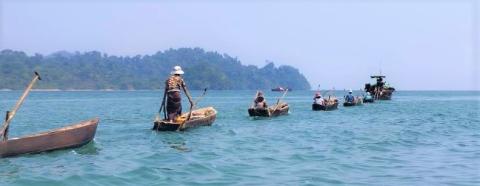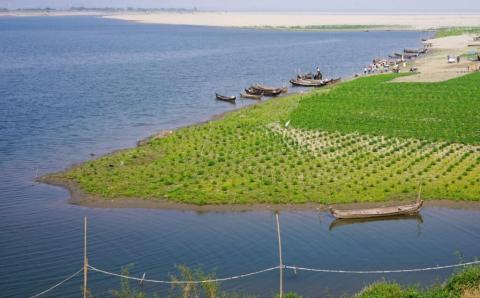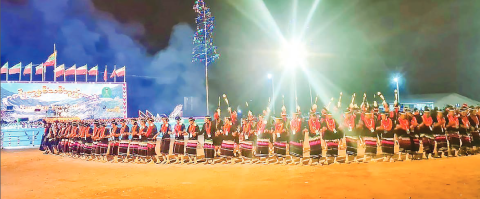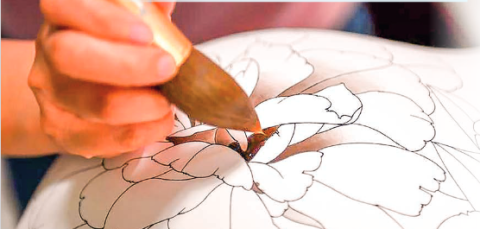The Sea Gypsies living in Kawthoung and Myeik districts of Taninthayi Region reap good profits for good capturing of squid.
The squid season is from April to September, and the squid is abundant between May and July. Although the Myanmar and Kayin fishermen in Myeik Archipelago do not go fishing in the monsoon season, the Salon people living on the island near the squid fishing areas hunt the squid in the daytime or at night when the weather is fine. They mostly capture the squid near the Thandani, Thandanet, Nyaungwi, Jalan and Salat Gayat islands.

The Sea Gypsies living in Kawthoung and Myeik districts of Taninthayi Region reap good profits for good capturing of squid.
The squid season is from April to September, and the squid is abundant between May and July. Although the Myanmar and Kayin fishermen in Myeik Archipelago do not go fishing in the monsoon season, the Salon people living on the island near the squid fishing areas hunt the squid in the daytime or at night when the weather is fine. They mostly capture the squid near the Thandani, Thandanet, Nyaungwi, Jalan and Salat Gayat islands.
The squids are usually caught using bait shaped like prawns made of rubber, which are attached to fishing lines. A piece of bait is placed on a line, and two lines are clipped to the fisher’s leg while fishing. The squid tend to come out more during the waxing moon days and full moon nights, when catches are better. At those times, they are mostly caught at night under the moonlight using small canoes at sea. During the waning and new moon days, they are mostly caught during the daytime.
The Salon fishermen skillfully capture the squids, and they transport them to Aung Bar San Pya village, where the products are exported to Ranong, Thailand. The wholesale agents in Aung Bar village purchase at K15,000 per kilogram, and the sales are good. The agents resell with baht to Thailand, and such action is a win-win situation for the squid farmers and resellers.
“The squids are abundant during these months, and the Salon people capture them even in the choppy seas. The offspring attend school in Makyone Kalet, and the parents and brothers catch the squids. Therefore, they do not live on the island for months like previously, and they send dried fish and cash. They previously lived in the sea. As they have proper knowledge and so they emphasize education. The Salon people catch the squid for their living. When the squid season is over, they go fishing or diving. The Myanmar and Kayin fishermen catch using nets. There are 96 households in Makyone Kalet village, and most of them are from Salon and Myanmar. Although the weather was rough and fine recently, the Salon caught the squids as usual, and made profits,” said U Tin Aung Moe, administrator of Makyone Kalet village.
The Salon fishermen return to their land of origin at the end of September, and they catch the spotted seer fish, giant trevally, batoid and lobster, and these products are exported to Thailand. During that season, some Salon people repair the boats and fishing nets, and some catch the squid. The Salon people use the sea as their pasture for their living, and the fragile Kaban boat as a home.
In the Kawthoung and Myeik Archipelago, Taninthayi Region, most of the Salon people live on Makyone Kalet, Lampi, Langan, Nyaungwi, Don Nyaung Hmine, Done Pale Aaw, Zardetgyi, Linlon and Kangyimaw islands, and Myanmar and Kayin people are also found there. — Thitsa (MNA)/KTZH
Source: GNLM
The Sea Gypsies living in Kawthoung and Myeik districts of Taninthayi Region reap good profits for good capturing of squid.
The squid season is from April to September, and the squid is abundant between May and July. Although the Myanmar and Kayin fishermen in Myeik Archipelago do not go fishing in the monsoon season, the Salon people living on the island near the squid fishing areas hunt the squid in the daytime or at night when the weather is fine. They mostly capture the squid near the Thandani, Thandanet, Nyaungwi, Jalan and Salat Gayat islands.
The squids are usually caught using bait shaped like prawns made of rubber, which are attached to fishing lines. A piece of bait is placed on a line, and two lines are clipped to the fisher’s leg while fishing. The squid tend to come out more during the waxing moon days and full moon nights, when catches are better. At those times, they are mostly caught at night under the moonlight using small canoes at sea. During the waning and new moon days, they are mostly caught during the daytime.
The Salon fishermen skillfully capture the squids, and they transport them to Aung Bar San Pya village, where the products are exported to Ranong, Thailand. The wholesale agents in Aung Bar village purchase at K15,000 per kilogram, and the sales are good. The agents resell with baht to Thailand, and such action is a win-win situation for the squid farmers and resellers.
“The squids are abundant during these months, and the Salon people capture them even in the choppy seas. The offspring attend school in Makyone Kalet, and the parents and brothers catch the squids. Therefore, they do not live on the island for months like previously, and they send dried fish and cash. They previously lived in the sea. As they have proper knowledge and so they emphasize education. The Salon people catch the squid for their living. When the squid season is over, they go fishing or diving. The Myanmar and Kayin fishermen catch using nets. There are 96 households in Makyone Kalet village, and most of them are from Salon and Myanmar. Although the weather was rough and fine recently, the Salon caught the squids as usual, and made profits,” said U Tin Aung Moe, administrator of Makyone Kalet village.
The Salon fishermen return to their land of origin at the end of September, and they catch the spotted seer fish, giant trevally, batoid and lobster, and these products are exported to Thailand. During that season, some Salon people repair the boats and fishing nets, and some catch the squid. The Salon people use the sea as their pasture for their living, and the fragile Kaban boat as a home.
In the Kawthoung and Myeik Archipelago, Taninthayi Region, most of the Salon people live on Makyone Kalet, Lampi, Langan, Nyaungwi, Don Nyaung Hmine, Done Pale Aaw, Zardetgyi, Linlon and Kangyimaw islands, and Myanmar and Kayin people are also found there. — Thitsa (MNA)/KTZH
Source: GNLM

There are over 100 ethnic groups living in Myanmar, and each ethnic group has its own unique culture, literature, and traditional customs. Among the rich cultural traditions of these ethnic groups, the craft of traditional boat-making is also one of them.
There are over 100 ethnic groups living in Myanmar, and each ethnic group has its own unique culture, literature, and traditional customs. Among the rich cultural traditions of these ethnic groups, the craft of traditional boat-making is also one of them.
In the past, people travelled by using rafts for waterways. Later, they came up with the idea of making dugout canoes carved from logs instead of using rafts. This idea was inspired by the sight of logs with hollow centres floating on water. Realizing that hollowed-out canoes were lighter than solid logs and could carry more load, they began crafting and using these dugout canoes for transportation.
From there, lighter types of boats such as Laung (canoes) and combined boats gradually emerged. In the past, crafting dugout canoes was a highly labour-intensive task, often taking several months to complete just one boat. The people used fallen trees for this purpose previously, but later they began selecting and cutting down long, straight trees specifically for making boats.
People use either paddles or oars. As is commonly known, oars are longer and broader than paddles, and they are usually used in pairs. However, the way of using oars can vary depending on the region.
In the eastern regions, oarsmen typically face toward the front of the boat while rowing. However, in Western countries, rowers usually sit facing the rear of the boat, rowing with their backs toward the direction they are heading. Although oars are generally used in pairs, in Western-style racing boats, each rower typically uses only a single oar. One unique feature of racing boats, compared to regular boats, is that small wheels are installed under the rower’s seat, allowing the seat to slide. This enables the rower to extend their reach and row with longer strokes. Racing boats come in different types, such as single, four-person, and eight-person crews.
During the reign of ancient Myanmar Kings, boat races were traditionally held as ceremonial events. These races were not only popular in Eastern countries, but are also celebrated seasonally in Western countries on a grand scale. Competitors in boat races must not only ensure that their boats are fast and well-prepared, but they themselves must also be in excellent physical condition. To build stamina and ensure harmonious rowing, they undergo strict training both on land and in water throughout the whole year.
Another type of boat race that is extremely popular in Western countries is the sailing race. These racing boats differ from ordinary boats in that they are designed with sleek and narrow shapes. The number of sails varies depending on the type of racing boat. The sizes of these boats also range from small 15-foot vessels to large racing yachts capable of crossing the Atlantic Ocean.
All around the world, there are many different types of boats and seasonal boat races are held every year. However, for those who row or sail, it is not enough to simply understand boats and water superficially. They must have a deep understanding of water dynamics and be highly skilled in rowing. Currently, people can use small boats, large boats, ferries, motor boats, and so on easily in every season or condition. However, the traditional boats are still used for fishing, transporting fruits and vegetables and boat racing events in Waso, Wagaung and Tawthalin months. — Zeya Naing (Shwe Kan Myay)/KTZH
Source: The Global New Light of Myanmar
There are over 100 ethnic groups living in Myanmar, and each ethnic group has its own unique culture, literature, and traditional customs. Among the rich cultural traditions of these ethnic groups, the craft of traditional boat-making is also one of them.
In the past, people travelled by using rafts for waterways. Later, they came up with the idea of making dugout canoes carved from logs instead of using rafts. This idea was inspired by the sight of logs with hollow centres floating on water. Realizing that hollowed-out canoes were lighter than solid logs and could carry more load, they began crafting and using these dugout canoes for transportation.
From there, lighter types of boats such as Laung (canoes) and combined boats gradually emerged. In the past, crafting dugout canoes was a highly labour-intensive task, often taking several months to complete just one boat. The people used fallen trees for this purpose previously, but later they began selecting and cutting down long, straight trees specifically for making boats.
People use either paddles or oars. As is commonly known, oars are longer and broader than paddles, and they are usually used in pairs. However, the way of using oars can vary depending on the region.
In the eastern regions, oarsmen typically face toward the front of the boat while rowing. However, in Western countries, rowers usually sit facing the rear of the boat, rowing with their backs toward the direction they are heading. Although oars are generally used in pairs, in Western-style racing boats, each rower typically uses only a single oar. One unique feature of racing boats, compared to regular boats, is that small wheels are installed under the rower’s seat, allowing the seat to slide. This enables the rower to extend their reach and row with longer strokes. Racing boats come in different types, such as single, four-person, and eight-person crews.
During the reign of ancient Myanmar Kings, boat races were traditionally held as ceremonial events. These races were not only popular in Eastern countries, but are also celebrated seasonally in Western countries on a grand scale. Competitors in boat races must not only ensure that their boats are fast and well-prepared, but they themselves must also be in excellent physical condition. To build stamina and ensure harmonious rowing, they undergo strict training both on land and in water throughout the whole year.
Another type of boat race that is extremely popular in Western countries is the sailing race. These racing boats differ from ordinary boats in that they are designed with sleek and narrow shapes. The number of sails varies depending on the type of racing boat. The sizes of these boats also range from small 15-foot vessels to large racing yachts capable of crossing the Atlantic Ocean.
All around the world, there are many different types of boats and seasonal boat races are held every year. However, for those who row or sail, it is not enough to simply understand boats and water superficially. They must have a deep understanding of water dynamics and be highly skilled in rowing. Currently, people can use small boats, large boats, ferries, motor boats, and so on easily in every season or condition. However, the traditional boats are still used for fishing, transporting fruits and vegetables and boat racing events in Waso, Wagaung and Tawthalin months. — Zeya Naing (Shwe Kan Myay)/KTZH
Source: The Global New Light of Myanmar

THE six travel zones are designated in Sagaing Region, which is rich in ancient heritage, religious buildings and handicrafts, for the local and foreign travellers aiming to boost the tourism sector. In Naga tourist designation, the culture and traditional customs of ethnic people and Saramati Peak await the travellers, according to the Directorate of Hotels and Tourism of Sagaing Region.
There are six tourism zones in Sagaing Region: Sagaing, Monywa, Shwebo, Katha, Kalay and Naga, and local travellers visit Mingun most in the Sagaing tourism zone.
THE six travel zones are designated in Sagaing Region, which is rich in ancient heritage, religious buildings and handicrafts, for the local and foreign travellers aiming to boost the tourism sector. In Naga tourist designation, the culture and traditional customs of ethnic people and Saramati Peak await the travellers, according to the Directorate of Hotels and Tourism of Sagaing Region.
There are six tourism zones in Sagaing Region: Sagaing, Monywa, Shwebo, Katha, Kalay and Naga, and local travellers visit Mingun most in the Sagaing tourism zone.
In the Naga tourism zone, travellers can enjoy the tradition, culture, and living style of Naga ethnic people and scenes of mountains in addition to the 12,622-foot-high Saramati Peak.
Moreover, Leshi, Lahe, Nanyun and Pansawng in the Naga Self-administered Zone boast natural beauty, and the Naga New Year Festival is held in Leshi and Lahe, and the new feast festival, snack festival, paddy festival and harvesting festival are also held seasonally. Among them, the new year festival is the most popular and attracts local and foreign travellers.
“It is now holiday season, and Sagaing Region, the cultural region welcomes local and foreign visitors. There are six tourism zones, and we arrange to ensure the accommodation of visitors in the Mingun cultural region in the Sagaing tourism zone. The Naga New Year Festival hosted hundreds of tourists before the outbreak of the COVID-19 pandemic. The Saramati Peak, which is popular among ASEAN travellers, is located in the Naga Hill region and is covered with snow in winter. The government holds the Naga New Year Festival from 14 to 16 January, and the local and foreign travellers are also interested in it.
The Naga region with its beautiful nature warmly welcomes the local and foreign travellers,” said U Myint Sein, head of the Directorate of Hotels and Tourism in Sagaing Region.
Visitors can get to Leshi by Yangon-Mandalay-Homalin flight, while by Yangon-Mandalay-Monywa-Khamti flight to Lahe. Currently, the Naga region hosts travellers from India.
The tourism season in Naga is from November to June. After the completion of the Chindwin River crossing the Htamathi Bridge, the people can go to the Indian border in addition to the Naga region at any time, and it can promote the tourism industry of Naga and the trade flows of the eastern part of the Chindwin River will be also developed. —Thitsa (MNA)/KTZH
Source: The Global New Light of Myanmar
THE six travel zones are designated in Sagaing Region, which is rich in ancient heritage, religious buildings and handicrafts, for the local and foreign travellers aiming to boost the tourism sector. In Naga tourist designation, the culture and traditional customs of ethnic people and Saramati Peak await the travellers, according to the Directorate of Hotels and Tourism of Sagaing Region.
There are six tourism zones in Sagaing Region: Sagaing, Monywa, Shwebo, Katha, Kalay and Naga, and local travellers visit Mingun most in the Sagaing tourism zone.
In the Naga tourism zone, travellers can enjoy the tradition, culture, and living style of Naga ethnic people and scenes of mountains in addition to the 12,622-foot-high Saramati Peak.
Moreover, Leshi, Lahe, Nanyun and Pansawng in the Naga Self-administered Zone boast natural beauty, and the Naga New Year Festival is held in Leshi and Lahe, and the new feast festival, snack festival, paddy festival and harvesting festival are also held seasonally. Among them, the new year festival is the most popular and attracts local and foreign travellers.
“It is now holiday season, and Sagaing Region, the cultural region welcomes local and foreign visitors. There are six tourism zones, and we arrange to ensure the accommodation of visitors in the Mingun cultural region in the Sagaing tourism zone. The Naga New Year Festival hosted hundreds of tourists before the outbreak of the COVID-19 pandemic. The Saramati Peak, which is popular among ASEAN travellers, is located in the Naga Hill region and is covered with snow in winter. The government holds the Naga New Year Festival from 14 to 16 January, and the local and foreign travellers are also interested in it.
The Naga region with its beautiful nature warmly welcomes the local and foreign travellers,” said U Myint Sein, head of the Directorate of Hotels and Tourism in Sagaing Region.
Visitors can get to Leshi by Yangon-Mandalay-Homalin flight, while by Yangon-Mandalay-Monywa-Khamti flight to Lahe. Currently, the Naga region hosts travellers from India.
The tourism season in Naga is from November to June. After the completion of the Chindwin River crossing the Htamathi Bridge, the people can go to the Indian border in addition to the Naga region at any time, and it can promote the tourism industry of Naga and the trade flows of the eastern part of the Chindwin River will be also developed. —Thitsa (MNA)/KTZH
Source: The Global New Light of Myanmar

LILING of Hunan Province boasts a long history of ceramic production. The city now has more than 650 ceramic production enterprises and nearly 200,000 related employees.
LILING of Hunan Province boasts a long history of ceramic production. The city now has more than 650 ceramic production enterprises and nearly 200,000 related employees.
In recent years, local ceramic production enterprises have intensified their efforts to improve the making techniques. Some of them have also organized ceramics-making experience activities and low-price shopping areas to attract tourists. In the first half of 2024, Liling has received over 4.3 million tourists, with a year-on-year increase of 51.34 per cent. — Xinhua
LILING of Hunan Province boasts a long history of ceramic production. The city now has more than 650 ceramic production enterprises and nearly 200,000 related employees.
In recent years, local ceramic production enterprises have intensified their efforts to improve the making techniques. Some of them have also organized ceramics-making experience activities and low-price shopping areas to attract tourists. In the first half of 2024, Liling has received over 4.3 million tourists, with a year-on-year increase of 51.34 per cent. — Xinhua

